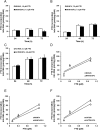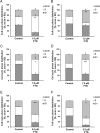Trifluridine/tipiracil overcomes the resistance of human gastric 5-fluorouracil-refractory cells with high thymidylate synthase expression
- PMID: 29568368
- PMCID: PMC5862589
- DOI: 10.18632/oncotarget.24412
Trifluridine/tipiracil overcomes the resistance of human gastric 5-fluorouracil-refractory cells with high thymidylate synthase expression
Abstract
Trifluridine/tipiracil (FTD/TPI or TFTD, also known as TAS-102) is a combination of the antineoplastic thymidine analog, FTD, and thymidine phosphorylase inhibitor, TPI (molar ratio 1:0.5). FTD/TPI was approved in Japan, the United States, and the European Union for the treatment of unresectable advanced or recurrent colorectal cancer. We evaluated the in vitro and in vivo efficacy and mechanisms of action of FTD and FTD/TPI against 5-fluorouracil (5-FU)-resistant MKN45/5FU, MKN74/5FU, and KATOIII/5FU human gastric cancer cells overexpressing thymidylate synthase (TS) and their respective parent cell lines. MKN45/5FU and KATOIII/5FU cells were not cross-resistant to FTD, whereas MKN45/5FU cells were 3.7-fold more resistant than the parental cells in vitro. FTD was also incorporated into genomic DNA in a concentration-dependent manner in 5-FU-resistant and parental cells. Additionally, deoxyuridine monophosphate levels in MKN45/5FU cells after 24-h FTD treatment were 3.0-fold higher than those in parental cells, and FTD treatment for 72 h induced G2/M arrest in MKN45/5FU cells, unlike the S phase arrest in MKN45 cells. Thus, TS-overexpressing MKN45/5FU cells, but not MKN74/5FU and KATOIII/5FU cells, showed partial cross-resistance to FTD. However, FTD/TPI (administered orally twice a day) exhibited antitumor activity to the same extent in MKN45 and MKN45/5FU xenograft mouse models, overcoming in vitro cross-resistance to FTD. DNA incorporation rather than TS inhibition seems to be the main action of FTD under these in vivo conditions. Thus, FTD/TPI is a promising chemotherapeutic agent against gastric cancers recurring following 5-FU therapy.
Keywords: 5-FU resistant cells; TAS-102; gastric cancer; trifluridine/tipiracil.
Conflict of interest statement
CONFLICTS OF INTEREST All authors are paid employees of Taiho Pharmaceutical Co., Ltd.
Figures






Similar articles
-
Combined efficacy and mechanism of trifluridine and SN-38 in a 5-FU-resistant human colorectal cancer cell lines.Am J Cancer Res. 2017 Dec 1;7(12):2577-2586. eCollection 2017. Am J Cancer Res. 2017. PMID: 29312810 Free PMC article.
-
A novel combination antimetabolite, TAS-102, exhibits antitumor activity in FU-resistant human cancer cells through a mechanism involving FTD incorporation in DNA.Int J Oncol. 2004 Sep;25(3):571-8. Int J Oncol. 2004. PMID: 15289858
-
Efficacy of Combination Chemotherapy Using a Novel Oral Chemotherapeutic Agent, TAS-102, with Oxaliplatin on Human Colorectal and Gastric Cancer Xenografts.Anticancer Res. 2015 Sep;35(9):4605-15. Anticancer Res. 2015. PMID: 26254349
-
TAS-102, a novel antitumor agent: a review of the mechanism of action.Cancer Treat Rev. 2015 Nov;41(9):777-83. doi: 10.1016/j.ctrv.2015.06.001. Epub 2015 Jun 6. Cancer Treat Rev. 2015. PMID: 26428513 Free PMC article. Review.
-
A systematic review of observational studies of trifluridine/tipiracil (TAS-102) for metastatic colorectal cancer.Acta Oncol. 2019 Aug;58(8):1149-1157. doi: 10.1080/0284186X.2019.1605192. Epub 2019 Apr 19. Acta Oncol. 2019. PMID: 31002008
Cited by
-
Loganetin and 5-fluorouracil synergistically inhibit the carcinogenesis of gastric cancer cells via down-regulation of the Wnt/β-catenin pathway.J Cell Mol Med. 2020 Dec;24(23):13715-13726. doi: 10.1111/jcmm.15932. Epub 2020 Oct 24. J Cell Mol Med. 2020. PMID: 33098378 Free PMC article.
-
Extracellular Adenosine in Gastric Cancer: The Role of GCSCs.Int J Mol Sci. 2025 Aug 6;26(15):7594. doi: 10.3390/ijms26157594. Int J Mol Sci. 2025. PMID: 40806724 Free PMC article.
-
Integrated analysis reveals a novel 5-fluorouracil resistance-based prognostic signature with promising implications for predicting the efficacy of chemotherapy and immunotherapy in patients with colorectal cancer.Apoptosis. 2024 Aug;29(7-8):1126-1144. doi: 10.1007/s10495-024-01981-2. Epub 2024 Jun 2. Apoptosis. 2024. PMID: 38824480
-
A novel intraperitoneal therapy for gastric cancer with DFP-10825, a unique RNAi therapeutic targeting thymidylate synthase, in a peritoneally disseminated xenograft model.Cancer Med. 2019 Dec;8(17):7313-7321. doi: 10.1002/cam4.2598. Epub 2019 Oct 14. Cancer Med. 2019. PMID: 31609087 Free PMC article.
-
Effective Sequential Combined Chemotherapy with Trifluridine/Tipiracil and Regorafenib in Human Colorectal Cancer Cells.Int J Mol Sci. 2018 Sep 25;19(10):2915. doi: 10.3390/ijms19102915. Int J Mol Sci. 2018. PMID: 30257515 Free PMC article.
References
-
- Jemal A, Bray F, Center MM, Ferlay J, Ward E, Forman D. Global cancer statistics. CA Cancer J Clin. 2011;61:69–90. - PubMed
-
- Temmink OH, Bijnsdorp IV, Prins HJ, Losekoot N, Adema AD, Smid K, Honeywell RJ, Ylstra B, Eijk PP, Fukushima M, Peters GJ. Trifluorothymidine resistance is associated with decreased thymidine kinase and equilibrative nucleoside transporter expression or increased secretory phospholipase A2. Mol Cancer Ther. 2010;9:1047–1057. - PubMed
-
- Murakami Y, Kazuno H, Emura T, Tsujimoto H, Suzuki N, Fukushima M. Different mechanisms of acquired resistance to fluorinated pyrimidines in human colorectal cancer cells. Int J Oncol. 2000;17:277–283. - PubMed
-
- Nakamura A, Nakajima G, Okuyama R, Kuramochi H, Kondoh Y, Kanemura T, Takechi T, Yamamoto M, Hayashi K. Enhancement of 5-fluorouracil-induced cytotoxicity by leucovorin in 5-fluorouracil-resistant gastric cancer cells with upregulated expression of thymidylate synthase. Gastric Cancer. 2014;17:188–195. - PMC - PubMed
LinkOut - more resources
Full Text Sources
Other Literature Sources
Research Materials
Miscellaneous

